
Designed upon an induction platform rather than rare-earth magnets, ABB has come out with a new version of its long-popular synchronous reluctance motors for industrial use that are highly energy efficient, meeting the new IE5 ultra-premium energy efficiency class defined by the International Electrotechnical Commission.
The IE5 ultra-premium SynRM motors offer up to 50 percent lower energy losses and significantly lower energy consumption than the commonly used IE2 induction motors. ABB first introduced its SynRM technology in 2011 and case studies in industrial installations have demonstrated energy savings of up to 25 percent, depending on the application.
The IE5 level of efficiency is made possible by the SynRM design which combines the performance advantages of permanent magnet technology with the simplicity and service-friendliness of an induction platform. To ensure an environmentally friendly design, the motors do not feature rear earth materials like permanent magnets, according to Tero Helpio, global product manager, IEC LV motors, ABB Motion.
“Climate change and environmental responsibility are driving huge changes across all industries”, said Helpio. “We have responded to this challenge with our IE5 ultra-premium motors that meet the most stringent energy efficiency standards. These motors offer industrial users a great opportunity to reduce their electricity usage and CO2 emissions while also benefiting from increased productivity and lower life-cycle costs.”
The idea is simple, says ABB. Take a conventional, proven stator technology and an innovative rotor design. Then combine them with a best-in-class industrial drive loaded with new, purpose-designed software.
The stator and rotor are made of similar electrical steel laminations as traditional induction motors, explained Helpio. The rotor has neither magnets nor windings and suffers virtually no power losses. Because there are no magnetic forces in the rotor, maintenance is as straightforward as with induction motors. The motor works on the basis of a magnetic flux created by the stator and controlled by the variable speed drive (VSD). The rotor tries to align itself relative to the stator flux. The VSD causes the flux to rotate and this pulls the rotor around with it, creating torque. The VSD monitors the rotor’s position to ensure it stays synchronized.
For more info, see www.abb.com.



